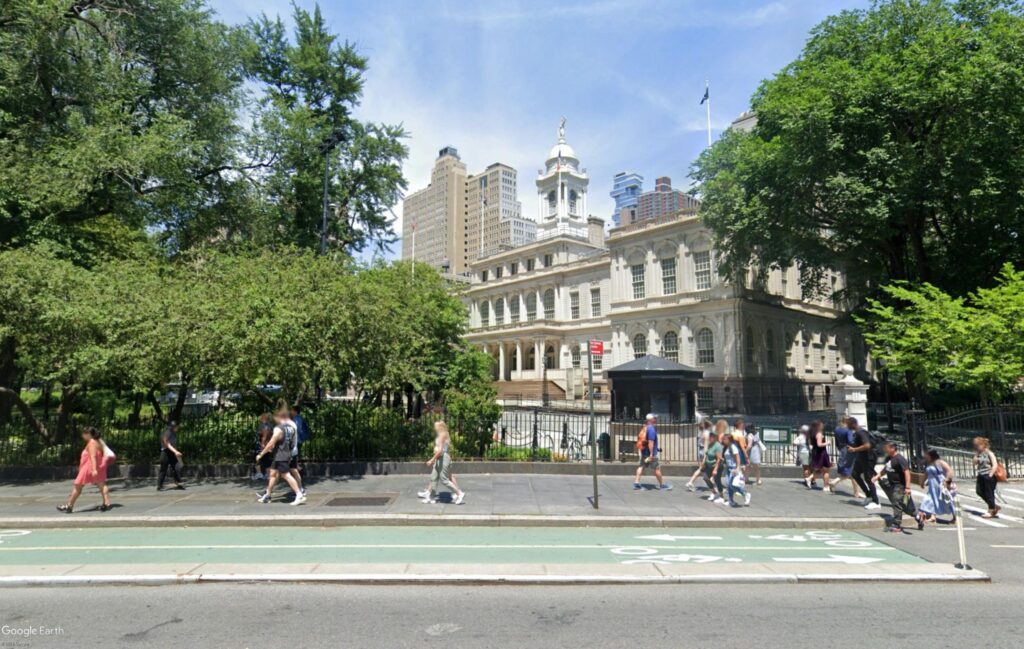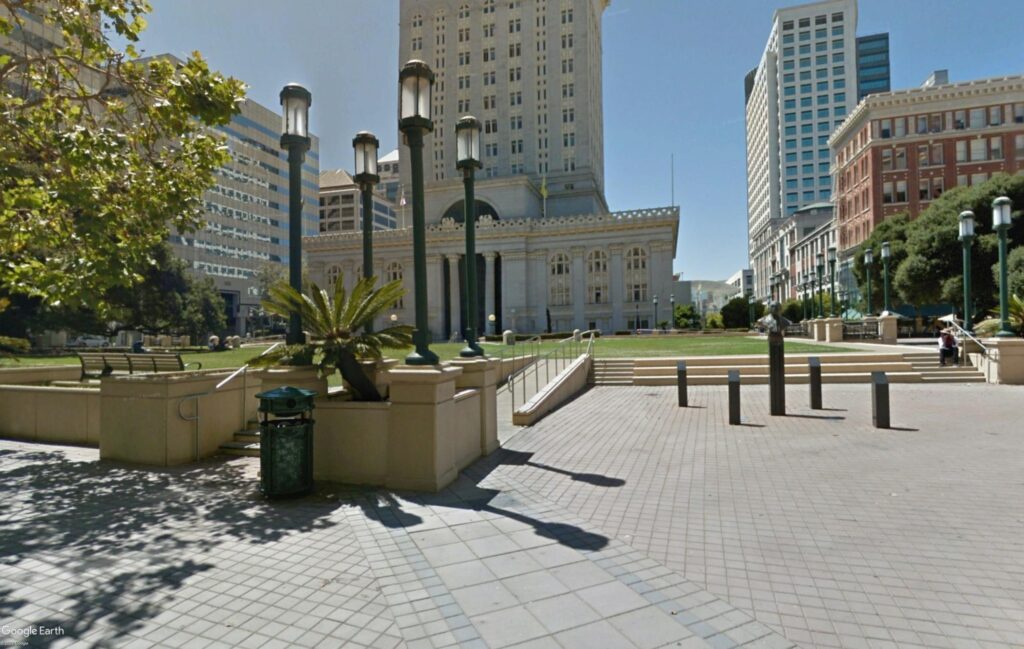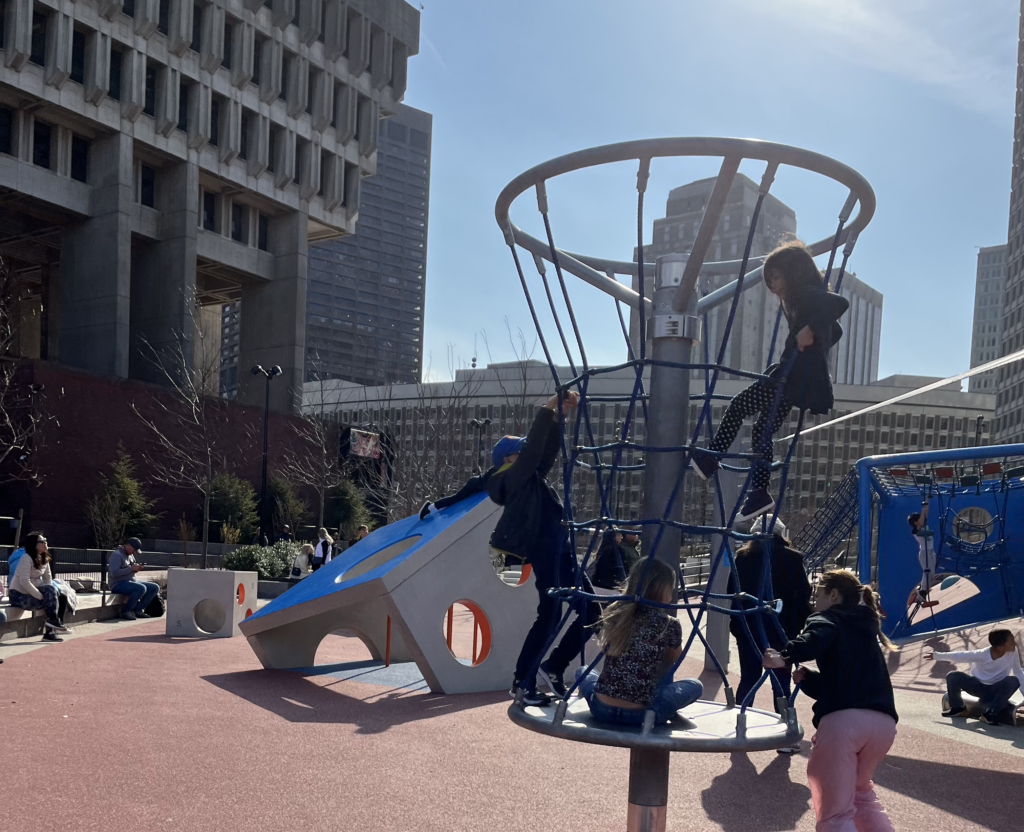Why We Need Federal Dollars to Design More Equitable City Halls
If city halls had adequate guidance and funding, they could do the job people think they are doing—and they could do it better.
“The security guard scares me… what’s happening?” I heard Sarah say as we waited outside a tall metal fence capped with spikes. Sarah and her friends go to public high schools across New York City. This was the first time they ever went to City Hall.
The security guards from the New York Police Department instructed us to enter five people at a time, empty our pockets, put our bags through the scanner, and walk through the metal detector. They took the scissors I was carrying from a design workshop I led earlier that day. I heard one guard say that they had to check bags because “kids can bring firearms too.”
The group’s first stop on the tour was a $10,000 statue of George Washington at the entryway. We passed through hallways and rooms filled with large, ornately framed oil paintings of white men next to velvet chairs roped off for historic preservation. I noticed the group looking tired and overheated, no place to sit or put our bags down. After finally being offered a seat on plastic fold-out chairs in the chamber, a few of the high schoolers asked me: how do they (council members, staff, advocates) work for hours in such an overwhelming, stuffy, dark room?
This experience of City Hall is not unique to young people in NYC. I have spent three years as an activist and urban designer, talking with people from underserved communities from across the country about how they feel in buildings where public policy gets made—from city halls to state assemblies to the White House. These conversations have all made one thing extremely clear: these buildings don’t serve us as well as they can and should.
What the young people did that day was an audit of the civic heart of their city. They examined the art, architecture, and design; they questioned the policies that continue to not only fund, but also preserve and glorify parts that make them feel unwelcome. The prognosis? If we truly care about the health of our democracy, we’ve got a lot of work to do. One place the federal government can start: examine the problem nationally and fund equitable, data-backed, locally-led design interventions on the ground. Equitable policy making has to live in equitable policy-making landscapes.
A Summary of What Federal Dollars Can and Should Do
These three federal investments would make a world of difference towards building more equitable civic life across the country:
1. Provide grants to support local design interventions working to promote equity.
2. Initiate an audit of how welcoming city halls are to show opportunities for growth.
3. Host a public online database to share knowledge about successful case studies.
1. Create a new federal funding stream to match historic preservation grants.
To date, the federal government plays a very small role in the design and maintenance of city hall buildings. While U.S. civil rights law states that every person has the right to equally enjoy public accommodations, the only way this law is actively translated into the on-the-ground physical architecture is through the 1990 Americans with Disabilities Act (see in particular the ADA Standards for Accessible Design). In theory, this creates an entrypoint for federal engagement with civic redesign.
One other way the federal government influences city hall buildings is through the Department of the Interior (DOI)’s grants and tax incentives for the preservation of national historic landmarks. Search the National Register of Historic Places and you will find a long list of city hall buildings across the country. Some of these buildings still operate as city halls today (e.g. Independence City Hall in Wisconsin, Burbank City Hall in California, and Tampa City Hall in Florida). Building maintenance, and the maintenance of historical buildings in particular, is expensive, and local policymakers looking to the federal government for support provides an important point of potential leverage.
However, not all cities have a NYC-size budget; in fact, not all states or countries do. In the absence of adequate funding and the reality of crumbling public infrastructure, many cities (over 300 on the National Register of Historic Places) use historic preservation grants to keep their city halls up and running. As the title of these grants suggests, it is extremely hard to change the design of a building once cities accept the money. Historic building typologies are preserved, but at what cost to the public today?
Today, the American Society of Civil Engineers gives the country a C- for infrastructure. So it’s clear that a majority of our infrastructure is in deep disrepair, and that investments are needed. DOI grants seem like an excellent opportunity to meet this need, but the mandate of these grants that apply to government public policy buildings—to preserve—points to their poor fit for the goal of a true civic overhaul. “Historical” designs are usually exactly the problem here, and so prioritizing them puts us at cross-purposes. For instance, a focus on preservation with no parallel federal funding stream to support reimagination, means that when a city hall is working to build an ADA-compliant ramp, it ends up with, as one young civic designer from the City of Cambridge pointed out to me, “accessibility… [but] through the back.” Access and equity are not the same. Here, equity becomes an afterthought rather than a design principle. We can, and must, do better.
Access and equity are not the same. Here, equity becomes an afterthought rather than a design principle.
If federal policymakers care about equity today, and long into our future, these historic preservation grants alone just won’t cut it. We cannot settle for patching up old buildings that do not serve us as best as they could anymore. Some of the city halls on the National Register have been converted into museums (ex: Mobile City Hall in Alabama). But some still operate as the heart of civic centers today. And, as Sarah and other people from underserved communities have pointed out, these hearts need some love. If we care about democracy, we need to design spaces that facilitate it rather than are barriers to it.
Since we currently have a federal funding stream that provides dollars for local historic preservation, at the very least, federal policymakers should provide a parallel funding stream: one that provides grants to support local city hall design interventions working to promote equity in the policy making space today. These design interventions can have the power to inspire a new generation of policy leaders who have felt like they don’t belong at City Hall. I know this because I have lived it, and I have heard it echoed by young people who I have the honor of working with on the ground.
2. Recipients of this federal grant can participate in a national audit that will show a fuller landscape of the problem—and reveal opportunities for growth.
Any city hall receiving federal funds for infrastructure should undergo an audit to see, well, just how well it’s serving its under-resourced users. Is the material landscape of city hall—from its plaza and entryway, to its signage, artwork, chambers, pop-up mobile units, and office spaces—acting as a bridge or barrier when it comes to, as President Biden’s executive order describes, “Advancing Racial Equity and Support for Underserved Communities?” And how is it doing when it comes to another recent executive order, “Transforming Federal Customer Experience and Service Delivery to Rebuild Trust in Government?” Now is the time to turn toward our civic infrastructure.
The audit should be conducted through an abolitionist, anti-imperialist lens and include both historical analysis as well as present-day qualitative and quantitative data collection on how under-resourced users experience the building, plaza, and any mobile sites. Users providing their design critique should be paid for their knowledge and expertise, just as outside design consultants would.
I asked the Library of Congress, and we currently do not have one comprehensive list of where all these critical physical policy spaces are, let alone any collective information about who designed them and if they’re helping us advance toward our national goal of implementing “services that are simple to use, accessible, equitable, protective, transparent, and responsive for all people of the United States.” An audit can help us access just that.
What we do know is that every single person who has served as the Architect of the Capitol since the position began in the 1700s has been a white man. Furthermore, many of our government buildings were created in architectural styles that glorify Western empire and monarchy. Who have been the architects of our city halls? What did they value? Who did they define as the “public” that their designs were meant to serve? Every design decision is a reflection of our values, and if we value democracy, we need to take an in-depth look at whether our civic buildings are bridges or barriers to it.
Every design decision is a reflection of our values, and if we value democracy, we need to take an in-depth look at whether our civic buildings are bridges or barriers to it.
Below are just a few of many organizations on the ground that the federal government should learn from when building policies and practices for designing more equitable civic spaces:
- BlackSpace
- Design As Protest
- Designing Justice + Designing Spaces
- Design Trust for Public Space
- Monument Lab’s National Monument Audit
- The Just City Lab
In 2015, Monument Lab highlighted the importance of City Hall design in Prototype Monument for Center Square by the late artist Terry Adkins, who designed a sculpture in front of Philadelphia City Hall that looks like an outdoor classroom. This temporary public art installation showcased “the history of the central courtyard of City Hall as a power spot; the center of a former public square that was a vehicle for commerce, announcement, education, and protest.”
A national audit of our city halls can show us what is working, what really isn’t, what’s at stake, and where we can move forward from here.
3. Creating a public online database where federal grant recipients share the progress of design interventions can lead to better outcomes nationally.
We need a public database from which we can not only analyze this network of buildings and evaluate their impact on democratic decision making, but also archive, track, and share creative design interventions.
This can be a space where creative, site specific, pilot programs that advance equity in city halls are shared nationally and internationally. This database would not only analyze these buildings and evaluate their impact on community engagement and democratic decision making, but also track and share innovative design interventions.
The three city halls highlighted below—in New York City, Oakland, and Boston—are a few examples of just what’s possible when there’s funding for local designs to support equitable policy making. There are many more built examples locally, nationally, and internationally that all levels of government can and should learn from, but there is currently no collective place to highlight and share this critical work. Sharing together, on this proposed platform and through conferences, we can evaluate, problem-solve, and build a better, more democratic future where no one feels scared when entering a civic space that is meant to serve them.
Here’s a starting point of what this database could look like. The database could grow to include photographs, impact reports, time-lines, budgeting, evaluation data, and design lead contacts for city staffers and elected officials to connect with if they’re interested in doing something similar at home.
New York City Hall (Federalist Style, 1812)

Some background:
- Designed in the early nineteenth century by architects Joseph François Mangin and John McComb Jr.
- Built by “Enslaved and free Africans [who] were largely responsible for the construction of the early city, first by clearing land, then by building… the first city hall.”
- Occupies unceded land of the Lenape people.
Some city-led design interventions:
- Access points for multiple forms of transit including trains, buses, and bikes
- A bike docking station and bike rack
- Wayfinding signs that include infographics and maps
- Signage available in multiple languages
- Seating, tables, and chess boards
- Building, park, and subway station are accessible by ramps
- Lighting
- Shade
- Green space
- Water fountains
- Culturally relevant artwork in the public garden
- Have started removing statues of racist and sexist figures
Oakland City Hall (Beaux Arts Style, 1914)

Some background:
- Designed by the New York-based firm Palmer and Hornbostel in the Beaux Arts style, which was “most often seen in places where turn-of-the- century wealth was concentrated, major urban centers and resort communities.” The style uses what is often referred to as “classical” architecture, which really means Greek and Roman, including elements such as columns, and ornamental, elaborate ceilings to “create a grand and imposing architectural statement.” Common building types associated with this style include courthouses, college buildings, churches, and mansions.
- Occupies the unceded “territory of xučyun (Huichin), the ancestral and unceded land of the Chochenyo-speaking Ohlone people.”
Some city-led design interventions:
- Access points for multiple forms of transit, including trains, buses, and bikes
- A welcome sign translated in many languages
- Wayfinding signs that include infographics and maps
- Accessible public space in front of the building, including tree canopies
- Accessible theater in front of the building
- Seating in both lit and shaded areas
- Building, park, and surrounding blocks are accessible
- Culturally relevant artwork
Boston City Hall (Brutalist Style, 1968)

Some background:
- Designed by Boston-based architectural firm Kallmann, McKinnell, and Knowles
- Occupies unceded territory of the Massachusett, Pawtucket, Wampanoag, and Nipmuc Peoples
- City Hall Plaza recently underwent a renovation to “move toward a more accessible, sustainable, and connected public space at Boston’s civic heart.” The project team includes the following agencies and organizations: the City’s Operations Cabinet, the Public Facilities Department, the Property Management Department, the Boston Planning and Development Agency, Sasaki, Skanska USA, and Shawmut.
Some city-led design interventions:
- Access points for multiple forms of transit, including trains, buses, and bikes
- Bike docks
- City Hall On the Go truck, a food-truck inspired mobile city hall van (completely redesigned from its original use as a SWAT vehicle) to take City Hall to the people of Boston
- Overhaul of entryway and communal spaces to make them more welcoming
- Culturally relevant artwork and a community art gallery
- Wayfinding signs that include infographics and maps
- Seating in both lit and shaded areas
- Cafe
- Lactation room
- Shaded areas
- Accessible plaza
- Building, park, and surrounding blocks are accessible
- Adding a bike docking station and bike rack
- Currently designing culturally relevant programming and reasons for people to come to City Hall and problem solve together
- Currently designing a City Hall On the Go truck, a food truck-inspired mobile city hall van (completely redesigned from its original use as a SWAT vehicle) to take City Hall to the people of Boston
Paving a Way Forward
While each of the city halls described above still has much work to do, they also each have a great deal to teach us about what’s possible, including within the confines of historical landmarks. Imagine what city halls across the country, including these ones, could do if they had access to federal guidance, funding, and a knowledge-sharing platform geared specifically towards designing more equitable policy spaces. As the American Institute of Architects says in their “Framework for Design Excellence: Design for Equitable Communities,” equitable design not only impacts the larger community: it’s also an investment in our collective future.
In the absence of a federal funding stream to support equitable city hall designs, some local councils have taken it upon themselves to fund interventions. That they’ve done so shows us three things: that there’s a need and willingness to reimagine these spaces, that there are local case studies to learn from, and that federal support could make these often costly infrastructural interventions a reality for more city halls across the country.
Design is powerful, and the data bear out the fact. Here are just two examples:.
- Harvard Healthy Buildings Program shows us that proper ventilation supports our cognitive performance and decision making.
- The UN, NIH, and GSA show that biophilic designs–designs that connect us with nature–can lower stress, help make us feel more comfortable, relaxed, and secure, and lead to higher levels of health, wellbeing, creativity, performance, and concentration.
As the planners, designers, and ex-public servants Casey Peterson, Lucas Teixeira Vaqueiro, and Judy Park Lee write, in their article “Ex Officio,” “Rather than dismissing these systems as unnecessarily bureaucratic and outdated, or trying to redesign them from scratch, it is becoming increasingly critical to examine these systems closely, including the values they express, the actors they engage, the props they use, the stages they occupy.”
Equitable evaluation, knowledge sharing, intervention, and maintenance may be costly—but not doing something, and soon, will cost us far more.
At a time when so many of us feel like we are moving further from the goal of democracy, together we can lay a roadmap to build and scale equitable, welcoming, policy spaces for all.

